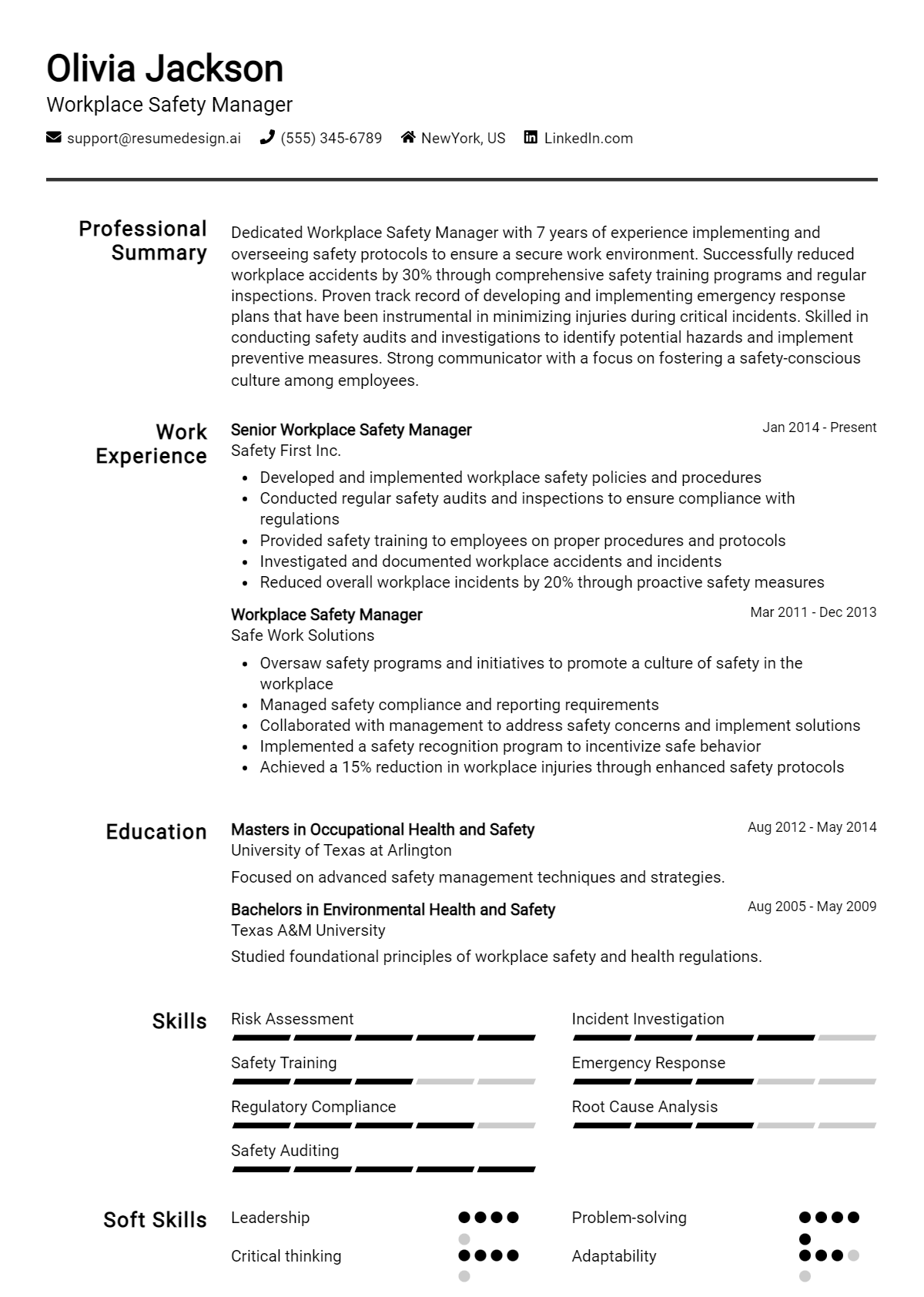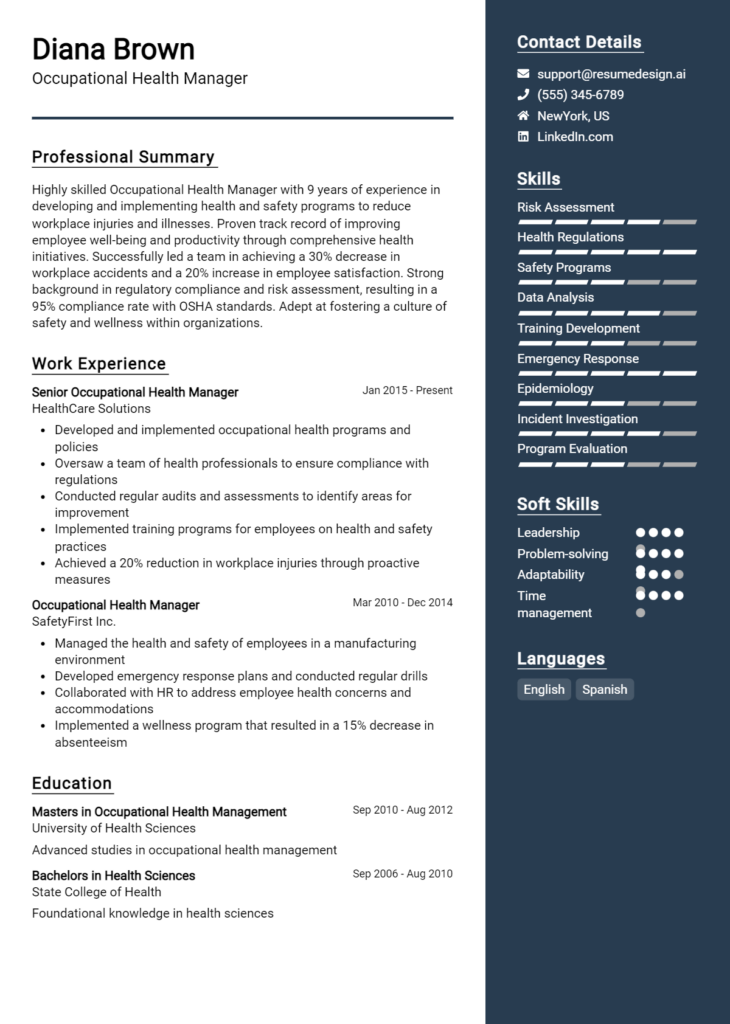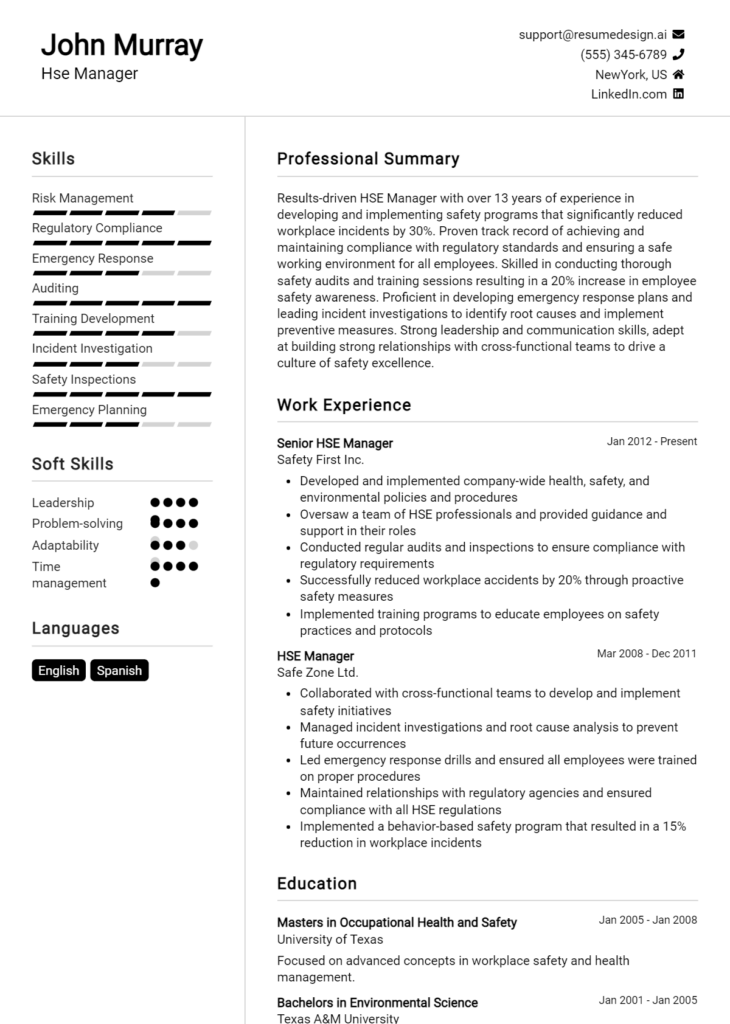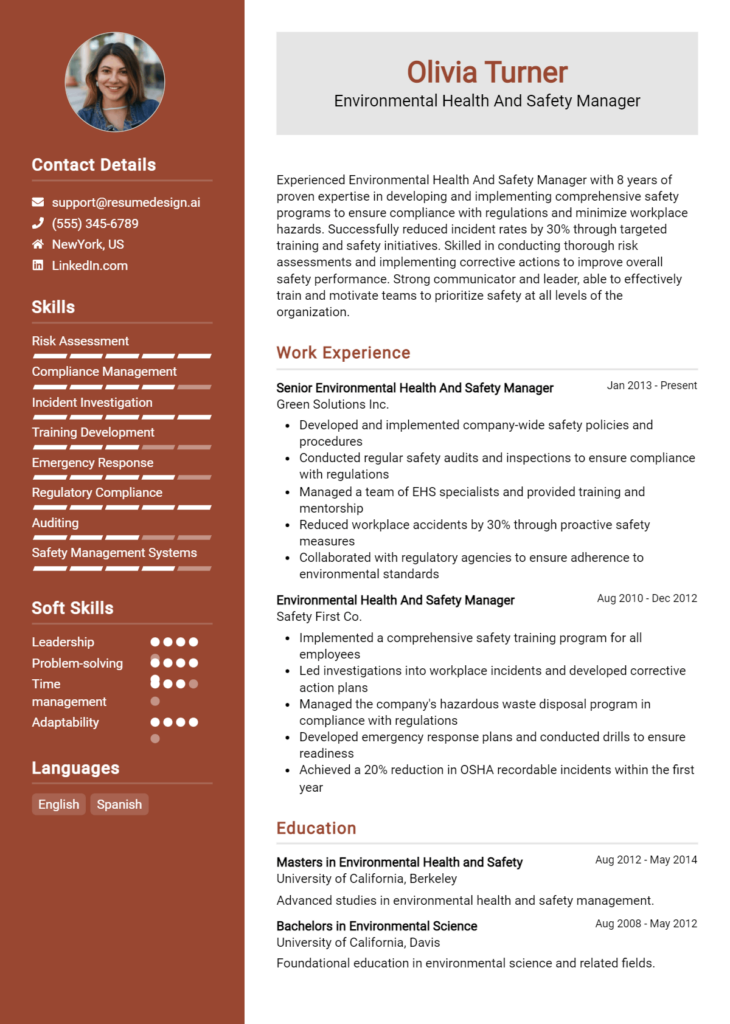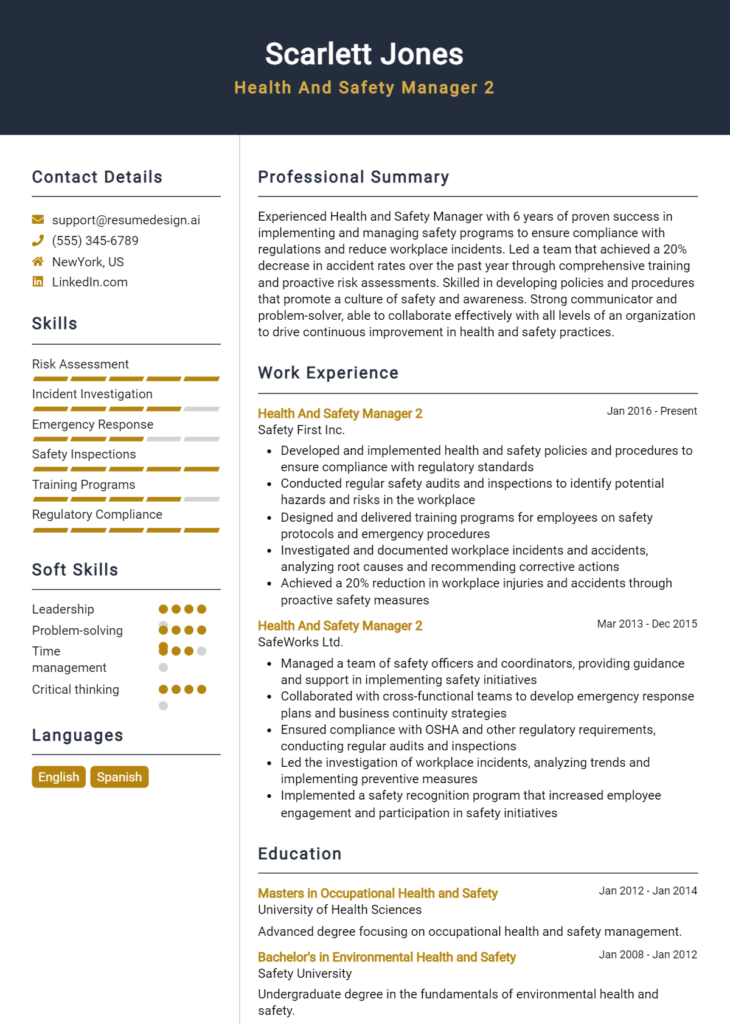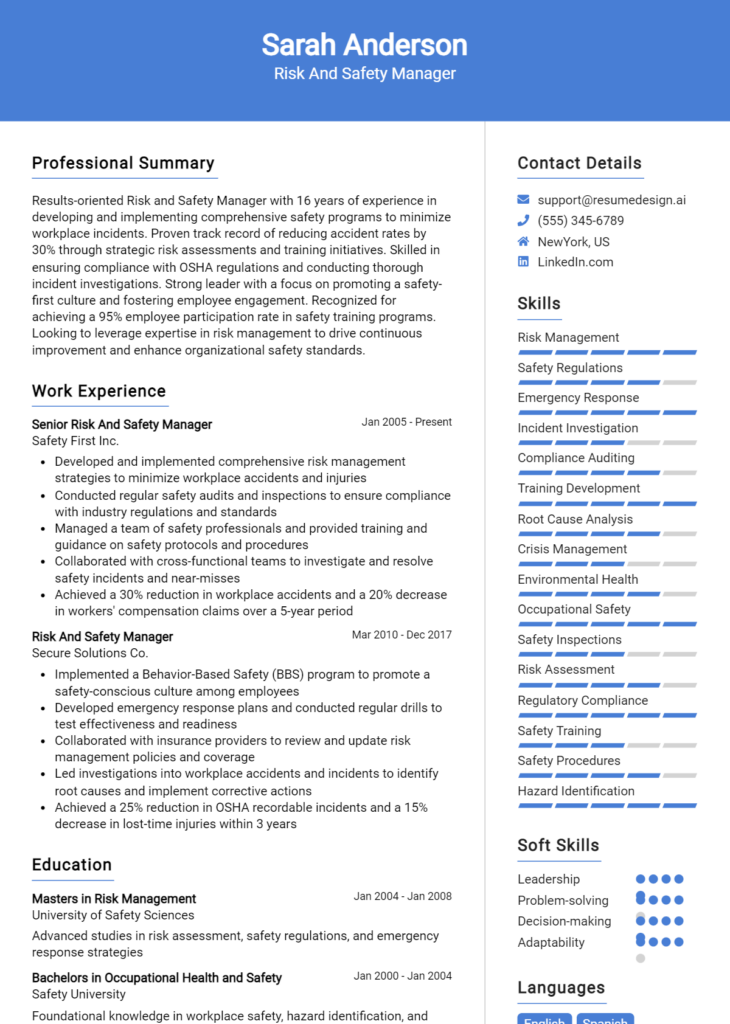Workplace Safety Manager Core Responsibilities
A Workplace Safety Manager plays a crucial role in ensuring a safe working environment by developing and implementing safety protocols across various departments. This professional must possess strong technical knowledge, operational insight, and problem-solving skills to effectively identify hazards and mitigate risks. By collaborating with HR, operations, and compliance teams, they foster a culture of safety that aligns with organizational goals. A well-structured resume can highlight these qualifications, showcasing the candidate's expertise and readiness to enhance workplace safety.
Common Responsibilities Listed on Workplace Safety Manager Resume
- Develop and implement safety policies and procedures.
- Conduct regular safety audits and risk assessments.
- Provide safety training and education to employees.
- Investigate workplace accidents and incidents.
- Ensure compliance with local, state, and federal safety regulations.
- Collaborate with management to improve safety measures.
- Maintain safety records and documentation.
- Monitor and analyze safety performance metrics.
- Advise on emergency response and evacuation plans.
- Coordinate safety meetings and workshops.
- Serve as a liaison between employees and regulatory agencies.
- Promote and foster a safety-first culture within the organization.
High-Level Resume Tips for Workplace Safety Manager Professionals
In today's competitive job market, a well-crafted resume is essential for Workplace Safety Manager professionals looking to make a lasting impression on potential employers. Your resume often serves as the first glimpse into your qualifications and experience, making it crucial that it effectively showcases your skills and achievements in the field of workplace safety. With the right approach, your resume can highlight not just your capabilities but also your commitment to promoting safety and compliance in the workplace. This guide will provide practical and actionable resume tips specifically tailored for Workplace Safety Manager professionals, ensuring that your application stands out among the rest.
Top Resume Tips for Workplace Safety Manager Professionals
- Tailor your resume to the job description by using specific keywords and phrases that reflect the requirements of the position.
- Start with a strong summary statement that encapsulates your experience and passion for workplace safety.
- Showcase relevant experience by detailing your previous roles in safety management, emphasizing your responsibilities and achievements.
- Quantify your achievements by including metrics such as reduced incident rates, successful audits, or cost savings achieved through safety initiatives.
- Highlight industry-specific skills, such as knowledge of OSHA regulations, risk assessment, and safety training programs.
- Include certifications and licenses relevant to workplace safety, such as Certified Safety Professional (CSP) or Occupational Health and Safety Technician (OHST).
- Utilize action verbs to convey your contributions effectively, making your accomplishments more dynamic and impactful.
- Incorporate professional development experiences, such as workshops or seminars, to demonstrate your commitment to continuous learning in safety management.
- Keep the layout clean and professional, ensuring that your resume is easy to read and visually appealing.
By implementing these tips, you can significantly enhance your chances of landing a job in the Workplace Safety Manager field. A targeted and polished resume will not only showcase your expertise but also communicate your dedication to fostering a safe work environment, making you an attractive candidate for potential employers.
Why Resume Headlines & Titles are Important for Workplace Safety Manager
In the competitive job market for Workplace Safety Managers, resume headlines and titles play a crucial role in making a strong first impression. A compelling headline can instantly capture the attention of hiring managers, providing a succinct summary of a candidate's key qualifications and strengths in just a few words. This brief yet impactful phrase should be tailored to reflect the specific demands of the role, showcasing relevant skills and experiences that align with workplace safety objectives. An effective headline is not only concise and relevant but also resonates with the goals of the organization, setting the stage for the rest of the resume.
Best Practices for Crafting Resume Headlines for Workplace Safety Manager
- Keep it concise: Aim for one to two impactful phrases that clearly convey your expertise.
- Be role-specific: Use terminology and keywords directly related to workplace safety management.
- Highlight key achievements: Incorporate measurable accomplishments to demonstrate your effectiveness.
- Use strong action words: Choose dynamic verbs that convey leadership and initiative.
- Tailor for the job: Customize your headline for each application to align with the job description.
- Showcase relevant certifications: Include credentials that signify your expertise in workplace safety.
- Emphasize your unique value: Highlight what sets you apart from other candidates in the field.
- Maintain professionalism: Ensure the tone and language reflect the seriousness of the role.
Example Resume Headlines for Workplace Safety Manager
Strong Resume Headlines
"Certified Workplace Safety Manager with 10+ Years of Experience Reducing Incident Rates by 30%."
“Proven Leader in Developing Safety Protocols that Enhance Compliance and Employee Well-Being.”
“Dynamic Safety Professional Specializing in Hazard Identification and Risk Assessment.”
Weak Resume Headlines
“Looking for a Job in Safety Management.”
“Safety Manager with Experience.”
The strong resume headlines are effective because they are specific, quantifiable, and tailored to the role of a Workplace Safety Manager, immediately conveying the candidate's expertise and value. In contrast, the weak headlines fail to impress due to their vagueness and lack of detail, offering no insight into the candidate’s qualifications or unique contributions. A strong headline not only attracts attention but also sets the tone for the potential employer to engage further with the resume.
Writing an Exceptional Workplace Safety Manager Resume Summary
A well-crafted resume summary is crucial for a Workplace Safety Manager, as it serves as the first impression a potential employer will have of a candidate. This brief but impactful section quickly captures the attention of hiring managers by highlighting key skills, relevant experience, and significant accomplishments that align with the job role. An effective summary should be concise, engaging, and tailored to the specific position being applied for, ensuring that the candidate stands out in a competitive job market.
Best Practices for Writing a Workplace Safety Manager Resume Summary
- Quantify Achievements: Use numbers and statistics to illustrate the impact of your contributions and improvements.
- Focus on Skills: Highlight key skills relevant to workplace safety, such as risk assessment, compliance management, and training development.
- Tailor the Summary: Customize your summary for each job application, reflecting the specific requirements of the job description.
- Be Concise: Aim for 3-4 sentences that are direct and to the point, avoiding unnecessary jargon.
- Showcase Leadership: Emphasize any leadership roles or initiatives that demonstrate your ability to lead safety programs.
- Include Certifications: Mention any relevant certifications, such as OSHA training or safety management credentials.
- Highlight Industry Experience: Specify industries you have worked in, particularly if they align with the employer's field.
- Demonstrate Continuous Improvement: Discuss any initiatives that led to improved safety metrics or reduced incident rates.
Example Workplace Safety Manager Resume Summaries
Strong Resume Summaries
Results-driven Workplace Safety Manager with over 10 years of experience in implementing safety programs that reduced workplace incidents by 40%. Proven track record in leading training sessions and conducting risk assessments to ensure compliance with OSHA regulations.
Dedicated safety professional with a strong background in the manufacturing industry, successfully decreasing injury rates by 25% through the development of new safety protocols and employee engagement initiatives. Certified in Six Sigma and OSHA standards.
Experienced Workplace Safety Manager adept at fostering a culture of safety across diverse teams. Achieved a 30% reduction in workplace accidents over two years by implementing effective training programs and safety audits.
Weak Resume Summaries
Safety Manager with experience in various industries. I have worked to improve safety and ensure compliance with regulations.
Dedicated professional looking to enhance workplace safety. I focus on ensuring employee well-being and following safety guidelines.
The strong resume summaries are considered effective because they provide specific outcomes, such as quantifiable reductions in workplace incidents and mention relevant skills and certifications. They also tailor the content to the role, showcasing the candidate's direct contributions to safety management. In contrast, the weak summaries lack specific achievements and are overly generic, failing to convey the unique value the candidate could bring to the organization.
Work Experience Section for Workplace Safety Manager Resume
The work experience section of a Workplace Safety Manager resume is crucial as it highlights the candidate's technical skills and their ability to effectively manage teams while delivering high-quality safety programs. This section not only reflects the candidate's hands-on experience but also demonstrates their capacity to implement safety protocols that align with industry standards. Quantifying achievements, such as reductions in incident rates or improvements in safety audit scores, is vital for showcasing the impact of their contributions. Furthermore, aligning past experiences with relevant industry benchmarks enhances the candidate's credibility and appeal to potential employers.
Best Practices for Workplace Safety Manager Work Experience
- Clearly describe safety programs you have implemented and their outcomes.
- Quantify achievements with specific metrics, such as reduced accident rates or compliance scores.
- Highlight collaboration with cross-functional teams to foster a culture of safety.
- Detail technical expertise in safety regulations, tools, and risk assessment methodologies.
- Use action verbs to convey responsibility and impact effectively.
- Tailor your experience to align with the job description and industry standards.
- Include training and certifications that enhance your qualifications in safety management.
- Showcase any leadership roles that demonstrate your ability to lead safety initiatives.
Example Work Experiences for Workplace Safety Manager
Strong Experiences
- Successfully reduced workplace incidents by 30% within one year through the implementation of a comprehensive safety training program and regular audits.
- Led a team of 10 safety officers to achieve 100% compliance with OSHA regulations, resulting in the organization receiving the Safety Excellence Award.
- Developed and executed a risk assessment strategy that identified and mitigated potential hazards, leading to a 25% decrease in insurance premiums.
- Collaborated with engineering and HR departments to design ergonomic workstations, improving employee satisfaction scores by 20% and reducing musculoskeletal injuries.
Weak Experiences
- Assisted in safety training sessions occasionally.
- Involved in safety audits without specifying the outcomes or improvements made.
- Helped implement safety measures but did not quantify the impact.
- Participated in meetings about safety regulations without detailing contributions or results.
The examples categorized as strong experiences are compelling because they include quantifiable outcomes and demonstrate clear leadership and collaboration in safety initiatives. They provide specific metrics that highlight success, making them more impactful to potential employers. Conversely, the weak experiences lack detail and fail to convey measurable results or significant contributions, which diminishes their effectiveness in showcasing the candidate's qualifications for the Workplace Safety Manager role.
Education and Certifications Section for Workplace Safety Manager Resume
The education and certifications section of a Workplace Safety Manager resume is crucial, as it showcases the candidate's academic qualifications and industry-specific credentials that are essential for ensuring workplace safety. This section not only highlights the necessary educational background but also emphasizes the candidate's commitment to continuous learning and professional development. By including relevant coursework, industry-recognized certifications, and specialized training, candidates can significantly enhance their credibility and demonstrate their alignment with the specific requirements of the job role, making a compelling case to potential employers.
Best Practices for Workplace Safety Manager Education and Certifications
- Include only relevant degrees and certifications that align with workplace safety management.
- Provide specific details regarding coursework that directly relates to safety regulations, risk management, and compliance.
- Highlight advanced degrees or certifications that indicate a higher level of expertise in the field.
- List industry-recognized certifications, such as Certified Safety Professional (CSP) or Occupational Health and Safety Technologist (OHST).
- Include any specialized training programs or workshops that demonstrate your commitment to staying current in the field.
- Ensure the section is organized chronologically or by relevance, making it easy for employers to assess qualifications quickly.
- Use clear and concise language, avoiding jargon that may not be universally understood.
- Continuously update this section as you gain new qualifications and certifications to keep your resume current.
Example Education and Certifications for Workplace Safety Manager
Strong Examples
- M.S. in Occupational Safety and Health, University of California, 2020
- Certified Safety Professional (CSP), Board of Certified Safety Professionals, 2021
- OSHA 30-Hour General Industry Training, Completed 2022
- B.S. in Environmental Science, University of Florida, 2018
Weak Examples
- High School Diploma, Anytown High School, 2010
- Certification in Basic First Aid (Expired 2019)
- Random Online Course in Health and Safety (Unrecognized Certification)
- Degree in Arts, University of Randomness, 2015
The strong examples are considered effective as they are directly relevant to the role of a Workplace Safety Manager, showcasing advanced education and recognized certifications that validate the candidate's expertise in safety management. Conversely, the weak examples reflect outdated or irrelevant qualifications that do not contribute to the candidate's suitability for the position, potentially undermining their professional profile.
Top Skills & Keywords for Workplace Safety Manager Resume
As a Workplace Safety Manager, possessing a well-rounded skill set is crucial for ensuring a safe and compliant work environment. The skills highlighted in your resume not only demonstrate your expertise but also reflect your ability to effectively manage safety protocols, engage with employees, and navigate complex regulations. A strong combination of soft and hard skills can set you apart in this competitive field, showing potential employers that you are capable of fostering a culture of safety while also implementing practical safety measures. For those looking to enhance their resume, focusing on the right skills is vital, as they convey your professional capabilities and readiness to tackle workplace challenges.
Top Hard & Soft Skills for Workplace Safety Manager
Soft Skills
- Communication
- Leadership
- Problem-Solving
- Attention to Detail
- Empathy
- Team Collaboration
- Adaptability
- Conflict Resolution
- Time Management
- Critical Thinking
- Decision Making
- Active Listening
- Negotiation
- Positive Attitude
- Training and Development
- Emotional Intelligence
Hard Skills
- OSHA Regulations Knowledge
- Risk Assessment Techniques
- Safety Audits and Inspections
- Incident Investigation
- Emergency Response Planning
- Safety Training Program Development
- Data Analysis and Reporting
- Environmental Health and Safety Compliance
- First Aid and CPR Certification
- Hazardous Materials Management
- Fire Safety Protocols
- Safety Equipment Usage
- Regulatory Compliance
- Ergonomics
- Construction Safety Standards
- Industrial Hygiene Practices
- Incident Reporting Software
- Safety Management Systems (SMS)
Having a blend of these skills will significantly enhance your work experience and effectiveness as a Workplace Safety Manager.
Stand Out with a Winning Workplace Safety Manager Cover Letter
I am writing to express my interest in the Workplace Safety Manager position at [Company Name] as advertised. With over [X years] of experience in workplace safety management and a proven track record of implementing effective safety programs, I am confident in my ability to contribute positively to your organization. My commitment to fostering a safe and compliant work environment aligns perfectly with [Company Name]’s dedication to excellence and employee well-being.
In my previous role at [Previous Company Name], I successfully developed and executed comprehensive safety training programs, which resulted in a [X%] reduction in workplace accidents over the course of [X years]. I conducted thorough risk assessments and safety audits, identifying potential hazards and implementing corrective measures to mitigate risks. My leadership skills allowed me to engage employees at all levels in safety initiatives, fostering a culture of safety awareness and responsibility within the organization. I am adept at collaborating with diverse teams to ensure compliance with OSHA regulations and other industry standards.
I am particularly impressed by [Company Name]’s commitment to innovation and sustainability in the workplace. I am eager to leverage my skills in data analysis and incident reporting to help drive continuous improvement in your safety protocols. Furthermore, my ability to communicate effectively with employees and management will ensure that everyone feels empowered to contribute to a safer work environment. I am excited about the opportunity to bring my expertise in workplace safety management to [Company Name] and help uphold its reputation as a leader in employee safety.
Thank you for considering my application. I look forward to the opportunity to discuss how my experience and vision for workplace safety can support [Company Name]’s goals. I am eager to contribute to a culture of safety that not only protects employees but also enhances overall organizational performance.
Common Mistakes to Avoid in a Workplace Safety Manager Resume
When crafting a resume for the role of a Workplace Safety Manager, it's crucial to present your qualifications and experience in a clear and compelling manner. However, many candidates make common mistakes that can hinder their chances of landing an interview. Avoiding these pitfalls can help you create a stronger resume that effectively showcases your skills and expertise in workplace safety.
Lack of Specificity: Failing to provide specific metrics or examples of safety improvements can make your accomplishments seem less impactful. Use numbers to highlight your achievements, such as reduced accident rates or successful training programs.
Ignoring Relevant Certifications: Not including essential safety certifications, such as NEBOSH or OSHA, can be a critical oversight. These credentials are often expected and can set you apart from other candidates.
Overly Technical Language: Using jargon or overly technical terms may alienate hiring managers who may not be familiar with specific industry terminology. Strive for clarity and ensure your resume is accessible to a broad audience.
Neglecting Soft Skills: Focusing solely on technical skills while overlooking soft skills like communication, leadership, and problem-solving can weaken your resume. Safety managers must effectively collaborate with various teams and communicate safety protocols.
Unorganized Format: A cluttered or poorly structured resume can make it difficult for employers to quickly understand your qualifications. Use clear headings, bullet points, and consistent formatting to enhance readability.
Generic Objective Statement: Using a vague or generic objective statement can fail to capture the attention of hiring managers. Tailor your objective to the specific role and company, emphasizing your commitment to workplace safety.
Inconsistent Employment Dates: Presenting employment dates in a confusing manner can raise red flags for potential employers. Ensure your job history is clearly listed with consistent formatting to avoid any ambiguity.
Failing to Customize for Each Application: Sending out a one-size-fits-all resume can be detrimental. Customize your resume for each position you apply for, aligning your skills and experiences with the specific job description and requirements.
Conclusion
As a Workplace Safety Manager, your role is crucial in creating a safe and compliant work environment. Key responsibilities include conducting risk assessments, developing safety policies, ensuring adherence to regulations, and training staff on safety protocols. Effective communication and the ability to analyze data are also vital for identifying potential hazards and implementing preventive measures.
In summary, having a well-crafted resume is essential to showcase your expertise and qualifications in workplace safety management. It’s the first step toward securing your next opportunity in this critical field. We encourage you to take the time to review and update your Workplace Safety Manager resume to stand out to potential employers.
To assist you in this process, explore the variety of resources available, including resume templates to help structure your document, a resume builder for easy customization, resume examples to inspire your content, and cover letter templates to complement your application. Take action today to ensure your resume reflects your skills and experiences effectively!

